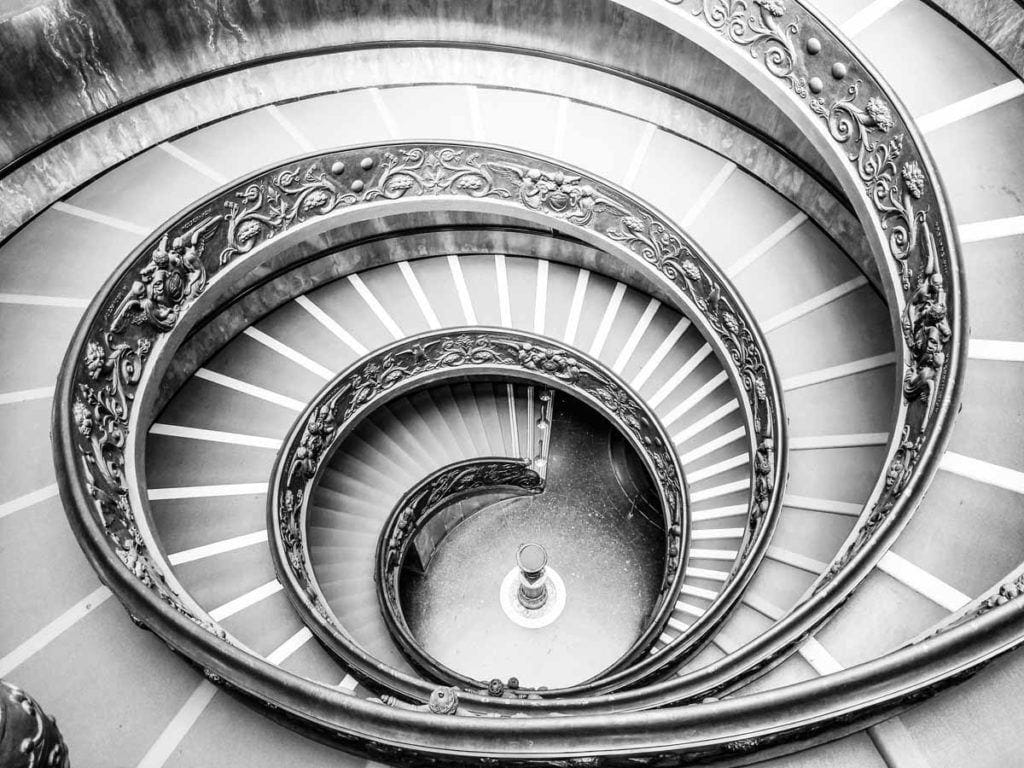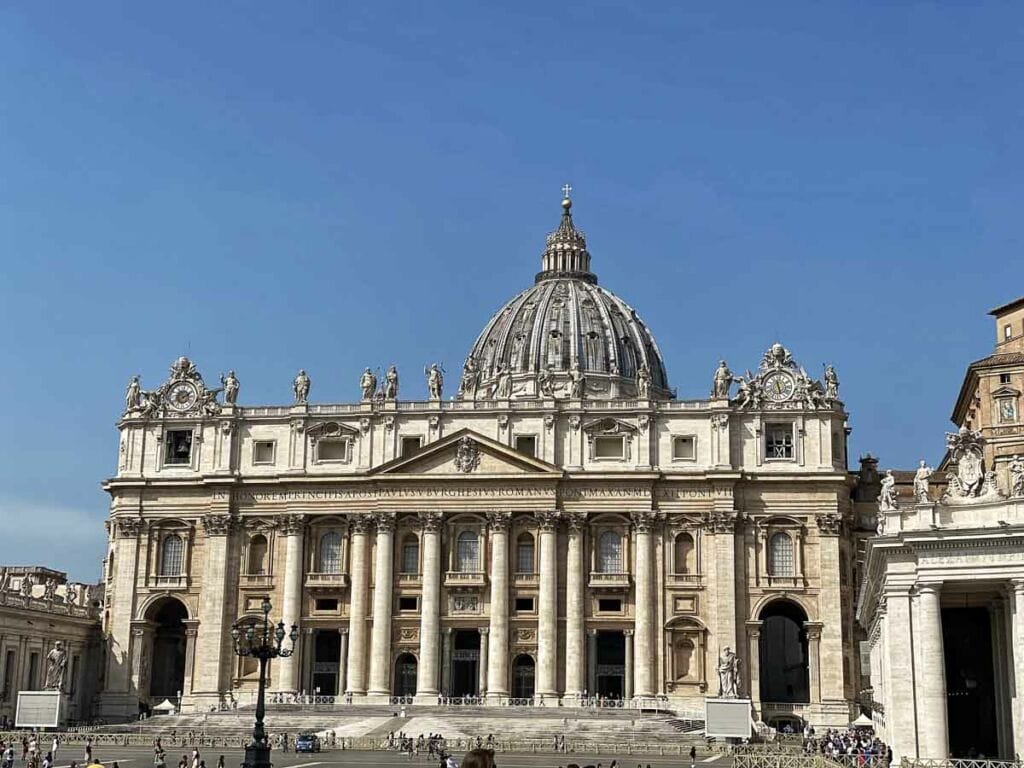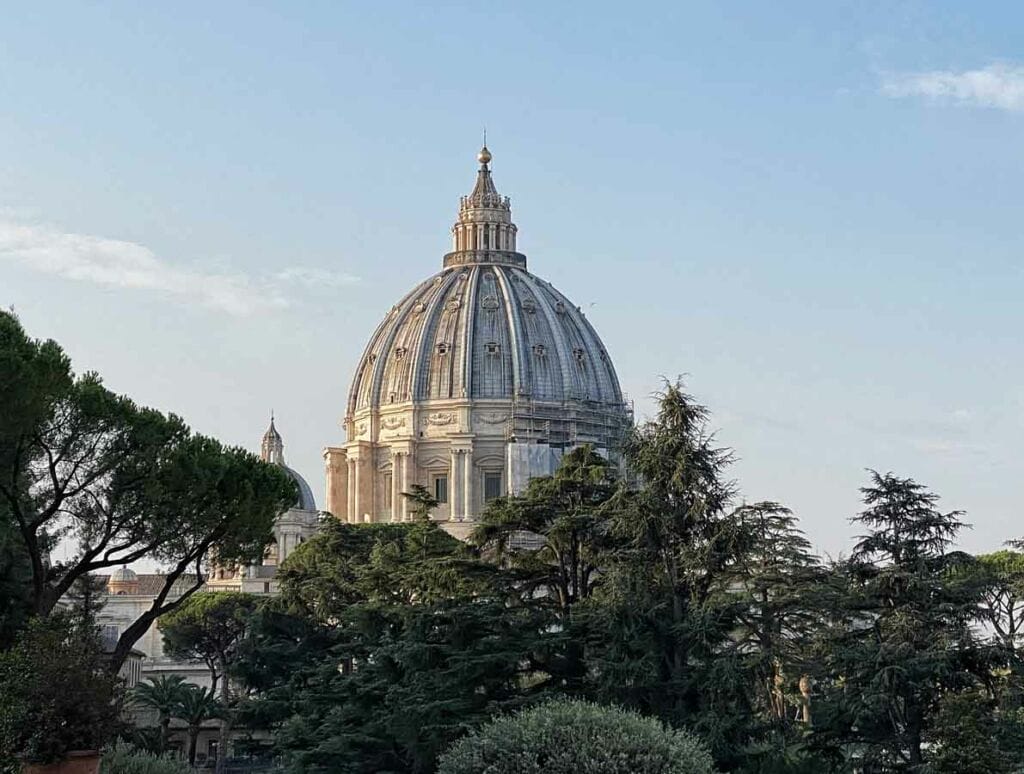Heading to Rome? Then you can’t miss checking out this article about the smallest country in the world! Keep reading to learn about the best things to do in Vatican City!
Visiting Vatican City? Get your skip-the-line tickets and tours here!
We love booking tours with GetYourGuide – the company offers a variety of activities, flexible booking, and 24/7 support!
- Vatican: Museums & Sistine Chapel Entrance Ticket – get your skip-the-line tickets at no extra charge!
- Rome: Vatican Museums, Sistine Chapel Tour and St. Peter’s – best-selling tour of the Vatican must-sees
- Rome: Guided Tour of St. Peter’s Basilica with Dome Climb – see Vatican City from above on the St. Peter’s Dome!
- Rome: Vatican Museums, Sistine Chapel, and Basilica Tour – Vatican museum tour led by a historian
- Rome: Saint Peter’s Basilica and Papal Tombs Audio Guide – discover the Vatican tombs with an archaeologist
There are many more things to do in Vatican City than you’d imagine. The smallest state in the world, which is surrounded by the city of Rome, is home to an incredible range of attractions and you may wish to spend days there to see them all.
While there are no hotels within the Vatican where you can stay, you can stay in Prati, one of the nicest neighborhoods in Rome, and cross the border to the Vatican any time you want to make the most of the many Vatican City attractions.
Curious to discover which are the unmissable things to do in Vatican City? Continue reading, as I will show all the Vatican City attractions you should not miss!
Did you know that Rome is wonderful in autumn? Please have a look at our guide about where to go in Italy in autumn!
13 Great Things To Do In Vatican City
Discover the secrets of Castel Sant’Angelo
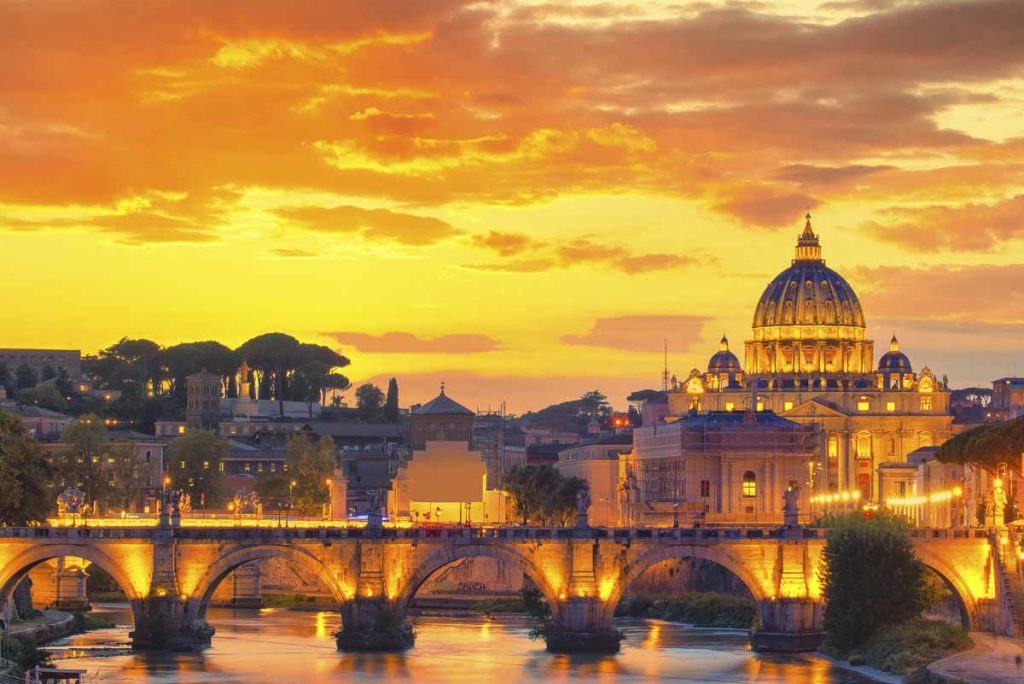
One of the most interesting Vatican City attractions is located outside the boundaries of the Holy See itself. But Castel Sant’Angelo is connected to the Papal Palace by way of a historic secret passage: the Passetto di Borgo.
The 800-meter long route was built as an escape route, and was used twice when the serving Pope of the time was in danger.
The Castel Sant’Angelo itself was originally built in the 1st century AD as the mausoleum for the Roman emperor Hadrian, but in later years was adapted as a fortress and castle (decommissioned in 1901).
Today you’ll find a museum here, which houses an interesting collection of Renaissance frescoes as well as historic weaponry and armor. From its terrace, you can enjoy incredible views of St. Peter’s Basilica.
Castel Sant’Angelo is open Tuesday to Sunday from 9:00 am to 7:30 pm. Admission is €12 + €1 booking fee. Advanced booking is required. Get your skip-the-line tickets here!
Stroll through the immaculate Vatican Gardens
Being a country the size of a small city, the Vatican boasts a disproportionate number of gardens. In fact, the gardens in the Vatican City take up more than half of the country’s land area, for a total of 23 hectares.
They consist of a number of both private and public parks and gardens; various styles can be seen here, from English to French and Italian. It’s a veritable green oasis among Rome’s otherwise quite urban landscape.
The Vatican Gardens themselves date back to the Medieval period, when they were orchards and vineyards. A major re-landscaping project took place in the 16th century, and many of the gardens still follow this Renaissance-era design.
They contain several interesting artifacts: statues, grottoes, and medieval fortifications can be seen among the manicured gardens. So if you want to get off the beaten track away from heavy crowds in other parts of the Vatican, the gardens are perfect for a breath of fresh air: this is one of the best things to do in Vatican City.
The Vatican Gardens can only be visited on open bus guided tours that cost €30 per person. You can book directly on the website of the Vatican Museums here though beware those tickets are not refundable.
If you wish to have a tour that includes the Vatican Gardens, the Vatican Museums and the Sistine Chapel, you can book a completely refundable option for €49 here!
Admire the collection at the Vatican Museums
One of the most famous Vatican City attractions – if not its biggest one – are the Vatican Museums. Millions flock to the country each year to see the enormous collection of work on display – there are over 70,000 masterpieces that have been amassed by successive Popes over the years (only a portion of which is ever on show). In total, there are 54 galleries at the Vatican Museums.
As you can imagine, there are some incredibly historic and important artworks here, from ancient Roman sculptures such as the famed Laocoön and His Sons, all the way to Renaissance paintings in the Pinacoteca.
Inaugurated in 1932, the Pinacoteca is perhaps most well-known for being home to the only painting by Leonardo da Vinci in Rome. Other artists represented at the Pinacoteca include Titian and Raphael (more on him later).
The Vatican Museums and Sistine Chapel are open Monday to Saturday from 8:30 am to 6:30 pm (last admission is at 4:30 pm). Make sure you book your Vatican Museum tickets in advance!
You can get your fully refundable tickets to the Vatican Museums and the Sistine Chapel here. If you’d rather join a guided tour, click here
Be wowed by the incredible Sistine Chapel
And the major draw of the very popular Vatican Museums has to be the Sistine Chapel – visiting is definitely one of the ultimate things to do in Vatican City. Officially known as the Great Chapel, this addition to the Apostolic Palace was undertaken in 1473. It’s full of beautiful Renaissance artwork and ornate architecture, but it is Michelangelo’s ceiling that is the landmark.
The frescoes on the ceiling of the Sistine Chapel are said to have changed the course of Western art, and have attracted countless visitors throughout history to admire its beauty. Since it is protected by copyright, no photography of any kind is allowed in any of the chapel.
You can visit the Sistine Chapel as the last stop of your visit to the Vatican Museums, which are open Monday to Saturday (check the official website for other closures during national holidays) from 8:30 am to 6:30 pm (last admission is at 4:30 pm).
See more masterpieces in the Raphael Rooms
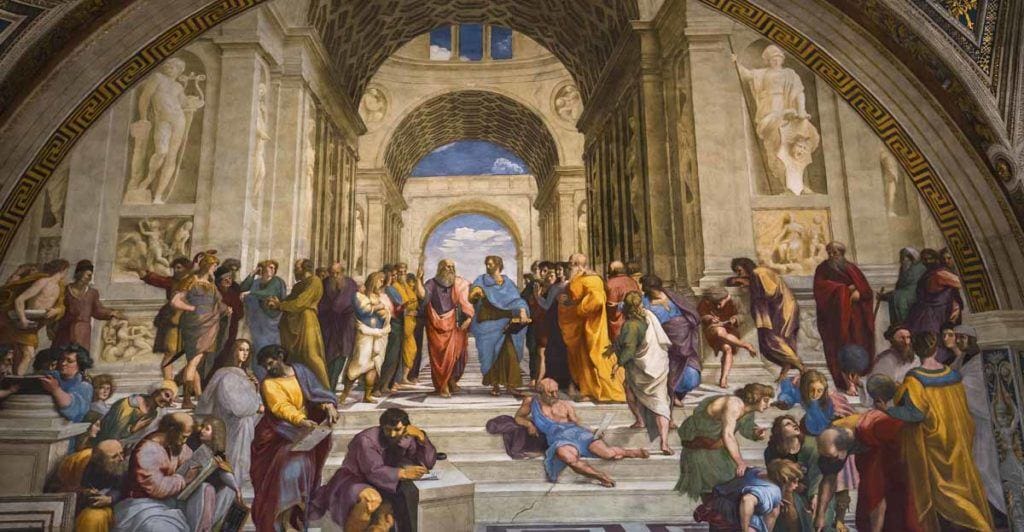
The Renaissance master Raphael (real name Raffaello Sanzio da Urbino) has an entire suite dedicated to his artwork. Well, more accurately, the artist and his workshop were the brains of the incredible frescoes that adorn the four rooms that make up the suite in the Vatican Museums.
The art was commissioned by then Pope Julius II, who wanted to outdo his predecessor (Pope Alexander VI, whom Julius II saw as a rival) and set out to create the most beautiful rooms ever.
The rooms are named: Hall of Constantine, Hall of Heliodorus, Room of the Signatura, and the Room of the Fire in the Borgo. They were created by Raphael between 1508 and 1524 and are easily among the best Vatican City attractions.
Marvel at the majesty of St. Peter’s Square
Probably the most visible part of the Vatican City, Piazza San Pietro has long been welcoming worshippers and well-wishers. This central point is arguably one of the most famous squares in the world, and first opened in 1666.
The square in its current form was designed by the Baroque architect Bernini, on the orders of Pope Alexander VII, who ordered a forecourt “so that the greatest number of people could see the Pope give his blessing, either from the middle of the façade of the church or from a window in the Vatican Palace.”
One of the first things you’ll notice is that the square isn’t a square at all: it’s a circle. Or rather, it’s a trapezium with rounded corners. The piazza is almost entirely encircled with Doric colonnades. From here, crowds gather to hear the Pope give blessings at Easter and other religious festivals.
One of the best things to do in Vatican City to get an incredible view of St. Peter’s Square from above is to climb St. Peter’s Dome – you can opt to climb up (551 steps) or take the elevator and climb the remaining part (320 steps). Tickets to access the dome cost between €8 and €10, depending on whether you want to opt for the elevator or not.
For a guided tour of St. Peter’s Basilica which includes the Dome climb, click here.
Check out the Egyptian obelisk
At the center of St. Peter’s Square is the Vatican Obelisk. This red granite Egyptian obelisk stands at just over 25 meters tall. It was originally erected at Heliopolis in Egypt in the 1st century AD, but was moved to where it currently stands in 1586 by Pope Sixtus V.
A base with bronze lions was added to the obelisk, and a cross was added to the top. Bernini utilized this ancient landmark as the centerpiece of his designs when he was creating the square. It still stands to this day, overseeing the many millions of visitors to the Vatican.
Hear a Papal address by the Pope himself
Although you may think that the chances of seeing the Pope while visiting Vatican City are rare, there are some opportunities to see the head of the Catholic Church while you are here – and in fact, this is one of the best things to do in Vatican City.
If you are in the city-state on a Wednesday, you may want to consider attending the Papal address. This gathering takes place in St. Peter’s Square during the summer months. Here people gather to hear the Pope offer a blessing to those in attendance.
The blessing is in Italian but it usually contains at least a few words of other languages peppered into it, including Latin, English, Spanish, Portuguese, Polish, and German.
There are also blessings extended to those who have passed away, or who are suffering from illnesses; significant objects can also be blessed. Everyone is welcome to attend the address, but it is ticketed.
Tickets to the Wednesday address can be obtained in advance – they are also free. But you should make sure to turn up early if you want a chance of getting a seat. Otherwise, you can book a guided tour of the Vatican Museums which also includes the Papal audience here.
If you don’t happen to be in Rome on a Wednesday, you may want to attend the Pope’s Angelus – his 20-minute address to the audience that takes place every Sunday at noon from one of the windows of his apartments. It’s completely free and no pre-bookings are required. You will have to go a bit in advance and pass through the security gates at St. Peter’s Square.
Overall it’s quite a unique opportunity to see the Pope in action; he can be seen during other religious festivals such as Easter.
Pay your respects at St. Peter’s Basilica
The history of St. Peter’s Basilica starts way back in the 4th century AD with Roman Emperor Constantine I. He set out to build a church over the shrine of St. Peter the Apostle which existed at the time.
Work on the current St. Peter’s Basilica began in 1506 under the orders of Pope Julius II, and it was completed 10 years later under Pope Paul V in 1516. It was an enormous undertaking. There was a succession of architects involved in the construction of the Basilica, including from the likes of Michelangelo and Raphael.
Today the momentous structure is the largest of all the Papal Basilicas, measuring 218 meters in length, and over 136 meters high. In fact, it is the largest church in the world, with a capacity of 60,000, and is undeniably an important place of pilgrimage for Catholics all over the world.
Visiting is an unforgettable experience and one of the unmissable things to do in Vatican City. And it’s not just about staying at ground level: you can take a tour up onto the dome to get some amazing views over Rome from a unique vantage point.
St. Peter’s Basilica is open daily from 7:00 am to 6:30 pm (October to March) and from 7:00 am to 7:00 pm (April to September). Admission is free, but you’ll have to go through security to get in.
For audioguide tours of St. Peter’s Basilica, click here. For guided tours which include the Dome climb, click here
Go underground at the Grottoes
Deep below St. Peter’s Basilica are a vast underground network of grottoes. This subterranean maze is the final resting place of over 90 Popes and other high dignitaries of the Catholic Church from the 10th century AD.
One particularly interesting part of the Grottoes is the Clementine Chapel. Here it is thought that the remains of St. Peter the Apostle are buried; the idea of the Pope’s tombs being down here is that they wanted to be buried as close as possible to the saint himself.
It’s best to take a tour down here. While the statues and architecture of these tunnels is impressive, it’s difficult to fully understand without having somebody in the know show you around. You can book your tour here
Purchase something duty-free at the Vatican Pharmacy
Taking a trip to buy some cosmetics may not be high up on your list of things to do in Vatican City, but don’t overlook this landmark pharmacy.
It is thought to be the busiest in the world – an estimated 2,000 visitors pass through the doors every day in search of medicines, as well as other lotions and potions.
Founded in 1874 by a monk, this pharmacy was originally established to supply Popes and Cardinals with medicine. It’s since become a place for anybody to shop.
Here you can find medicinal products that aren’t often on sale elsewhere in Italy, and even luxury perfumes. Things they don’t sell include items that aren’t in line with Catholic teachings, such as contraceptives.
Part of the pharmacy’s popularity is its price: the products on offer here are duty-free, and often around 12-25% cheaper than you can find elsewhere in Rome.
Get a unique stamp or coin at the Vatican Philatelic and Numismatic Office
Not only does the Vatican have its own pharmacy: the city-state also has its own post office. Established in 1929, the Vatican postal system is said to be very efficient. It’s responsible for both stamps and coins (because the Vatican also mints its own Euro coins that are decorated with depictions of Popes through the ages).
If you want to send a postcard during your trip to the Vatican City, make sure to visit the Vatican Philatelic and Numismatic Office. Located to the right-hand side of St. Peter’s Square, and open between 8:30 am and 6:30 pm, this institution is not to be missed.
Here it is also possible to buy Vatican stamps – including special limited edition versions. If you can’t get to the post office, you can use the mobile post office which is often stationed in the square.
For those who are keen stamp collectors, you may want to purchase some stamps at the Vatican museums, where collectors’ editions are sold. Regular stamps can be bought at gift shops, too. Once you’ve found the right stamp for you, affix it to your postcard, and post it in one of the bright yellow post boxes found around the Vatican City.
Learn about the tiny tiles at the Vatican Mosaic Studios
Away from the crowds and the big sights of the Vatican City is the lesser-visited Vatican Mosaic Studios. This off-the-beaten-track institution offers up a look behind the scenes at one of the most highly decorated city-states in the world.
The Vatican Mosaic Studios may not be the most awe-inspiring or eye-catching building in the nation, but it is here that beautiful works of art are produced and restorations are made. The studios are responsible for the care of mosaic works of art found within St. Peter’s Basilica, as well as producing their own mosaics for individuals.
Don’t go rushing here to buy any souvenirs, however: prices of mosaics can reach into the hundreds of thousands of Euros. But that’s because you’re paying for the high degree of skill and prestige attached to the artisans of the Vatican itself.
If you are interested in visiting, note that this can only be done on a private guided tour – given the compact size of the studios, it’d be difficult to imagine hordes of tourists crammed into the space!

